The Plasma Bottle Market is estimated to be valued at USD 1.1 billion in 2025 and is projected to reach USD 1.8 billion by 2035, registering a compound annual growth rate (CAGR) of 4.5% over the forecast period.
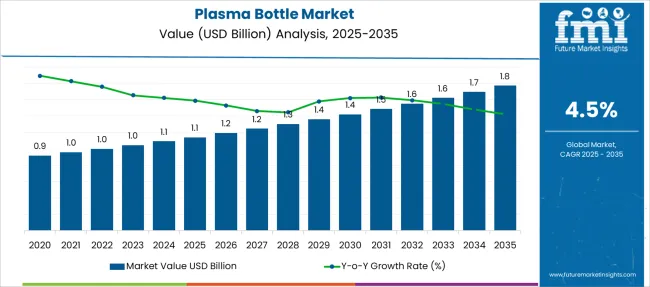
| Metric | Value |
|---|---|
| Plasma Bottle Market Estimated Value in (2025 E) | USD 1.1 billion |
| Plasma Bottle Market Forecast Value in (2035 F) | USD 1.8 billion |
| Forecast CAGR (2025 to 2035) | 4.5% |
The plasma bottle market is experiencing steady growth, driven by rising demand in healthcare and pharmaceutical sectors for reliable and sterile containers. The importance of safe storage and transport of plasma and biological samples has led to increased focus on container quality and material properties.
Advances in manufacturing technologies have enabled the production of high-quality bottles with enhanced durability and chemical resistance. Growing awareness about contamination prevention and the need for maintaining plasma integrity during storage are key factors supporting market expansion.
Additionally, rising investments in blood banks and plasma collection centers globally are contributing to increased demand. The market outlook remains positive as innovations in design and material science improve container performance and ease of use. Segmental growth is expected to be driven by Glass as the preferred raw material, Cylindrical shape due to its practicality and space efficiency, and bottles with capacity up to 50ml reflecting common storage needs.
The market is segmented by Raw Material, Shape, Capacity, and End Use and region. By Raw Material, the market is divided into Glass, Type I, Type II, and Plastics. In terms of Shape, the market is classified into Cylindrical, Rectangular, and Tubular. Based on Capacity, the market is segmented into Upto 50ml, Upto 100ml, Upto 250ml, Upto 500ml, and Upto 1000ml. By End Use, the market is divided into Pharmaceuticals, Healthcare & Medical, Research & Development, and Defense. Regionally, the market is classified into North America, Latin America, Western Europe, Eastern Europe, Balkan & Baltic Countries, Russia & Belarus, Central Asia, East Asia, South Asia & Pacific, and the Middle East & Africa.
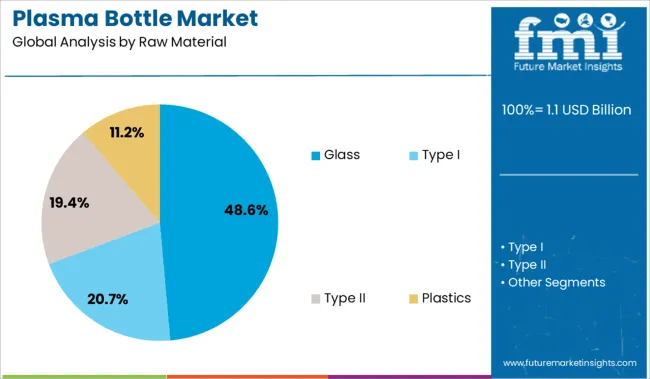
The Glass segment is projected to hold 48.6% of the plasma bottle market revenue in 2025, maintaining its position as the dominant raw material choice. Glass is favored for its inert nature, preventing chemical reactions with plasma and ensuring sample purity.
Its excellent barrier properties protect against moisture and gas permeability, which are critical for maintaining plasma stability. Additionally, glass bottles are resistant to high temperatures, allowing for sterilization without compromising integrity.
The durability and transparency of glass also support visual inspection and quality control processes. As plasma handling protocols become more stringent, glass continues to be the preferred material due to its reliability and safety features.
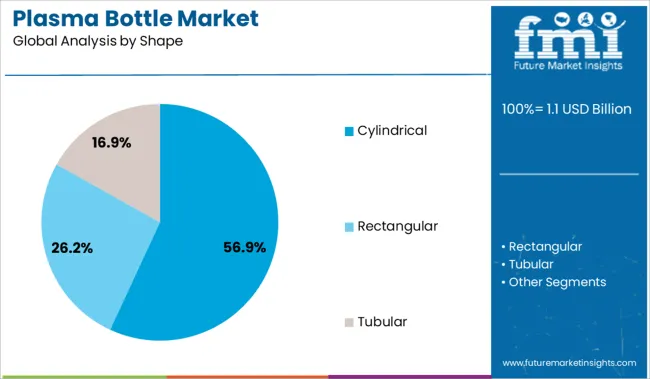
The Cylindrical shape segment is expected to contribute 56.9% of the plasma bottle market revenue in 2025, reflecting its widespread use in medical and laboratory applications. Cylindrical bottles offer uniform wall thickness and structural strength, making them suitable for high-pressure storage and transport conditions.
Their shape facilitates efficient stacking and packing, optimizing space in storage units and transport containers. Moreover, cylindrical bottles are easier to handle and compatible with automated filling and sealing equipment, improving operational efficiency.
The simplicity of this shape also supports standardized manufacturing processes and reduces production costs. These advantages have made cylindrical plasma bottles the preferred choice in many healthcare settings.
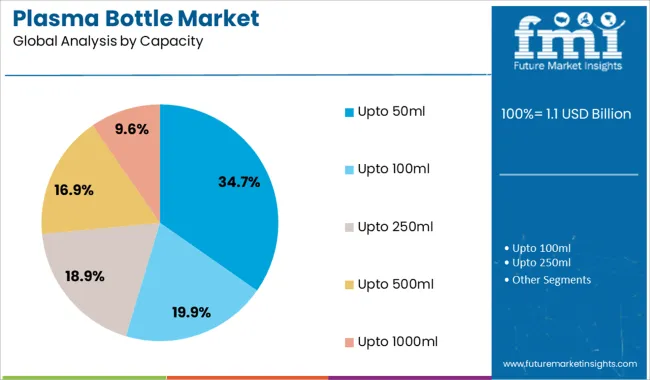
The Up to 50ml capacity segment is projected to account for 34.7% of the plasma bottle market revenue in 2025, establishing itself as the leading size category. This capacity range aligns with typical plasma sample volumes collected for diagnostic and therapeutic purposes.
Smaller bottle sizes offer benefits in terms of ease of handling, reduced storage space, and minimized wastage. Healthcare providers often prefer bottles within this capacity for single-use applications, ensuring sample integrity and preventing cross-contamination.
Additionally, this size supports efficient sample transport and processing in clinical laboratories. With the growing number of diagnostic tests and plasma therapies, demand for bottles of this capacity is expected to remain strong.
With growing vehicular fleet and rising traffic congestion, there is a substantial increase in number of road accidents across the world, creating strong demand for associate treatments and supplements. For instance, according to a survey by the National Crime Records Bureau, in 2024, approximately 354,796 incidences of road accidents were reported in India.
This rising burden of road accidents is accelerating the demand for blood and blood components for the patients with high blood loss. As plasma bottles are extensively used for safe collecting, storing, packaging, and transportation of blood components, surging need for blood components is estimated to create lucrative growth opportunities in the global market.
In addition to this, the leading plasma bottle manufacturers are constantly aiming at adopting novel production processes for manufacturing plasma bottles with varying sizes, shapes, and colors with minimum defects, which is expected to favor the growth in the market.
Presence of stringent standards and norms for the development and approval of sterile medical packaging solutions across regions such as North America, Europe, and Asia Pacific is projected to restrain the growth in the global plasma bottle market.
Also, implementation of strict regulations regarding the use of plastics, due to the rising concerns regarding disposal and environmental impact is expected to hamper the demand for plasma bottles across the plastics segment.
As per Future Market Insights, South Asia is forecast to account for the lion’s share in the plasma bottle market between 2025 and 2035.
Due to the growing burden of road accidents and increasing prevalence of blood-related diseases across Asia Pacific, a significant rise in blood & blood component transfusion is being witnessed in the countries such as India, Thailand, Bangladesh, and others.
For instance, according to a report by the Friends2support Organization, around 50 Million units of blood are required each year and nearly 30 Million units of blood components such as plasma are transfused every year in India. As plasma bottles are extensively used across numerous medical banks for transportation of blood components, increasing need for blood transfusion is expected to facilitate the growth in the South Asia market.
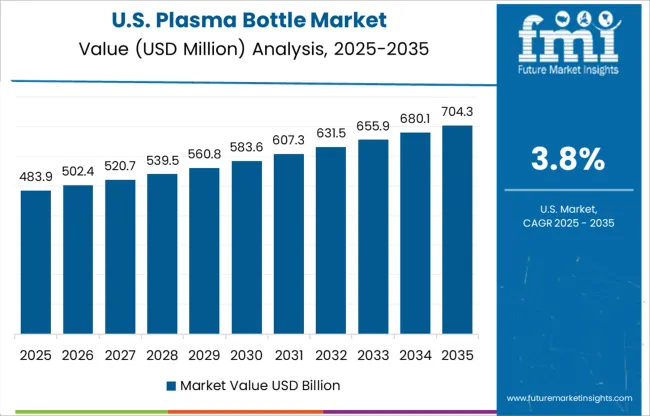
North America is expected to account for a significant share in the global plasma bottle market during the forecast period 2025 to 2035, states FMI.
With growing focus on proper storage and transportation of blood components in maximum hygienic conditions for maintaining the quality of blood, the demand for novel medical packaging solutions such as plasma bottles is rapidly increasing.
Also, launch of new guidelines on Human Blood and Transfusion Services by the New York State Council for processing and administration of plasma is further elevating the adoption of disinfected plasma storage solutions. This is anticipated to bolster the sales of plasma bottles in the North America market.
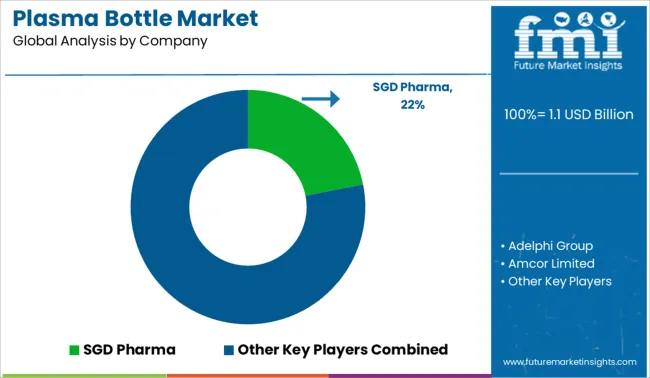
Some of the leading players in the plasma bottle market are SGD Pharma and Adelphi Group. These players are increasingly focusing on launching new products to expanding their product portfolio and adoption production capacity expansion and agreement strategies for strengthening their footprint.
| Report Attribute | Details |
|---|---|
| Growth Rate | CAGR of 4% to 5% from 2025 to 2035 |
| Base Year for Estimation | 2024 |
| Historical Data | 2020 to 2024 |
| Forecast Period | 2025 to 2035 |
| Quantitative Units | Revenue in USD Million, Volume in Kilotons and CAGR from 2025 to 2035 |
| Report Coverage | Revenue Forecast, Volume Forecast, Company Ranking, Competitive Landscape, Growth Factors, Trends and Pricing Analysis |
| Segments Covered | Raw Material, Shape, End Use, Region |
| Regions Covered | North America; Latin America; Europe; East Asia; South Asia; Oceania; Middle East and Africa |
| Key Companies Profiled | SGD Pharma; Adelphi Grou; Others |
| Customization | Available Upon Request |
The global plasma bottle market is estimated to be valued at USD 1.1 billion in 2025.
The market size for the plasma bottle market is projected to reach USD 1.8 billion by 2035.
The plasma bottle market is expected to grow at a 4.5% CAGR between 2025 and 2035.
The key product types in plasma bottle market are glass, type i, type ii and plastics.
In terms of shape, cylindrical segment to command 56.9% share in the plasma bottle market in 2025.






Full Research Suite comprises of:
Market outlook & trends analysis
Interviews & case studies
Strategic recommendations
Vendor profiles & capabilities analysis
5-year forecasts
8 regions and 60+ country-level data splits
Market segment data splits
12 months of continuous data updates
DELIVERED AS:
PDF EXCEL ONLINE
Competitive Overview of Plasma Bottle Industry Share
Plasma Dynamic Air Sterilizer Market Size and Share Forecast Outlook 2025 to 2035
Plasma Cutting Machine Market Size and Share Forecast Outlook 2025 to 2035
Plasma Powder Market Size and Share Forecast Outlook 2025 to 2035
Plasma Separation Tubes Market Trends – Demand & Forecast 2025 to 2035
Plasma-Derived Drugs Market
Plasma Protein System Market
Plasma-derived Protein Therapies Market
Plasma Lighting Market
RF Plasma Generators Market
CNC Plasma Cutting Machines Market Size and Share Forecast Outlook 2025 to 2035
Mycoplasma Plate Antigens Market Size and Share Forecast Outlook 2025 to 2035
Cold Plasma Market – Growth, Demand & Forecast 2025 to 2035
Rapid Plasma Reagin Test Market
Remote Plasma Source Market
Arc-based Plasma Lighting Market Size and Share Forecast Outlook 2025 to 2035
Platelet Rich Plasma Market Analysis - Size, Share, and Forecast Outlook 2025 to 2035
Specialty Control Plasma Market - Demand & Forecast 2025 to 2035
Spray-dried Animal Plasma (SDAP) Market Size and Share Forecast Outlook 2025 to 2035
Europe Platelet Rich Plasma (PRP) Market Growth – Trends & Forecast 2025 to 2035

Thank you!
You will receive an email from our Business Development Manager. Please be sure to check your SPAM/JUNK folder too.
Chat With
MaRIA